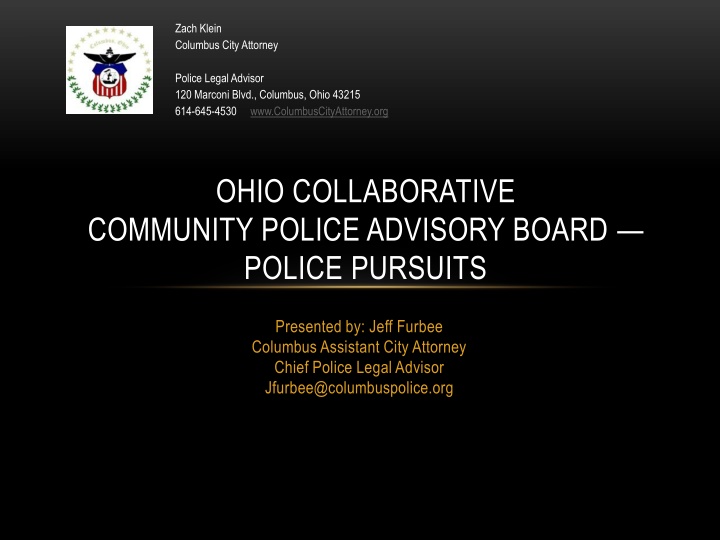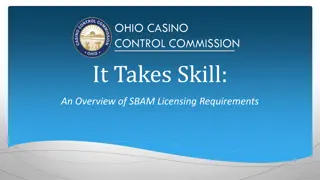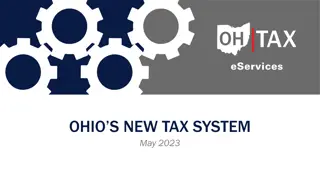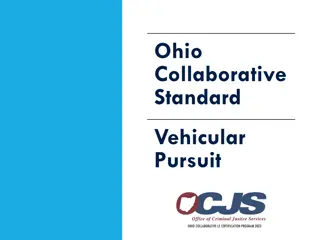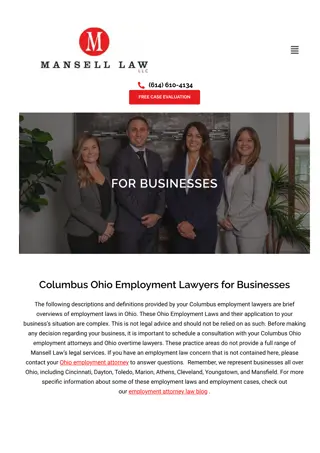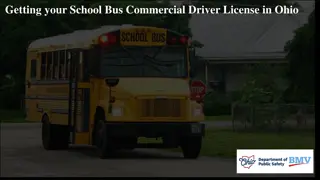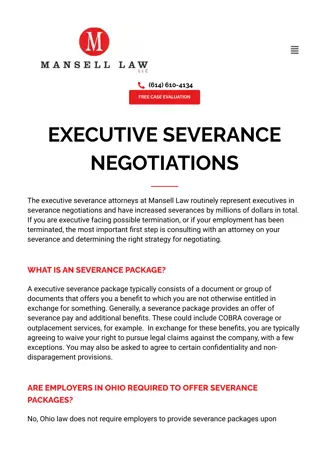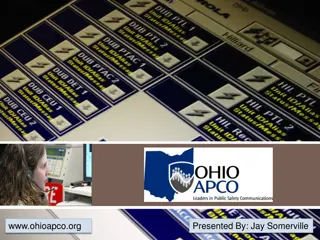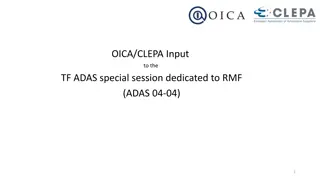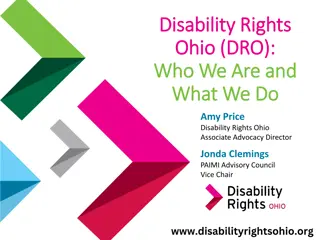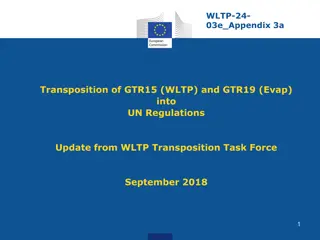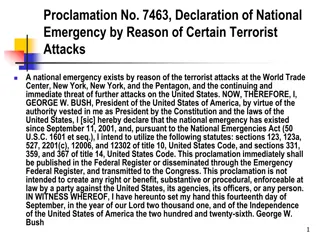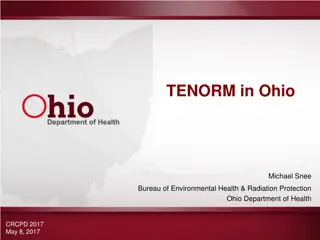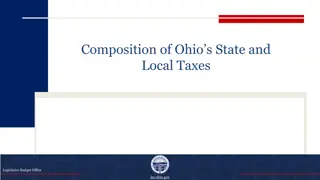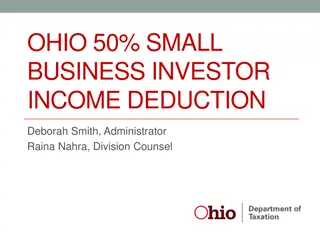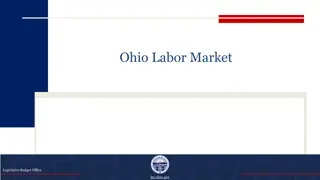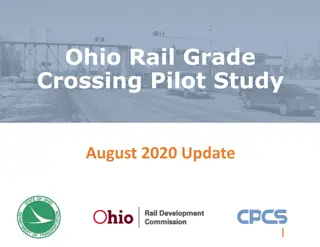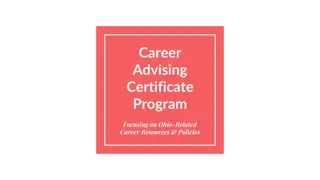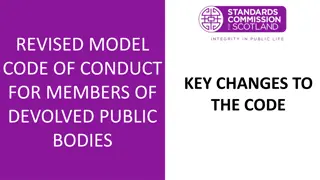Ohio Revised Code Sections on Emergency Vehicle Regulations
Explore the Ohio Revised Code sections pertaining to emergency vehicles, covering exemptions for emergency vehicle drivers in response to emergency calls, procedures for proceeding past red signals, and speed limit exceptions. These regulations ensure that emergency vehicles can navigate safely while responding to emergencies, prioritizing the safety of all individuals on the road.
Download Presentation

Please find below an Image/Link to download the presentation.
The content on the website is provided AS IS for your information and personal use only. It may not be sold, licensed, or shared on other websites without obtaining consent from the author.If you encounter any issues during the download, it is possible that the publisher has removed the file from their server.
You are allowed to download the files provided on this website for personal or commercial use, subject to the condition that they are used lawfully. All files are the property of their respective owners.
The content on the website is provided AS IS for your information and personal use only. It may not be sold, licensed, or shared on other websites without obtaining consent from the author.
E N D
Presentation Transcript
Zach Klein Columbus City Attorney Police Legal Advisor 120 Marconi Blvd., Columbus, Ohio 43215 614-645-4530 www.ColumbusCityAttorney.org OHIO COLLABORATIVE COMMUNITY POLICE ADVISORY BOARD POLICE PURSUITS Presented by: Jeff Furbee Columbus Assistant City Attorney Chief Police Legal Advisor Jfurbee@columbuspolice.org
RELEVANT OHIO REVISED CODE SECTIONS
4511.041 EXCEPTIONS FOR EMERGENCY OR PUBLIC SAFETY VEHICLE RESPONDING TO EMERGENCY CALL Sections 4511.12,,,, of the Revised Code do not apply to the driver of an emergency vehicle or public safety vehicle if the emergency vehicle or public safety vehicle is responding to an emergency call, is equipped with and displaying at least one flashing, rotating, or oscillating light visible under normal atmospheric conditions from a distance of five hundred feet to the front of the vehicle and if the driver of the vehicle is giving an audible signal by siren, exhaust whistle, or bell. This section does not relieve the driver of an emergency vehicle or public safety vehicle from the duty to drive with due regard for the safety of all persons and property upon the highway.
4511.03 EMERGENCY VEHICLES TO PROCEED CAUTIOUSLY PAST RED OR STOP SIGNAL (A) The driver of any emergency vehicle or public safety vehicle, when responding to an emergency call, upon approaching a red or stop signal or any stop sign shall slow down as necessary for safety to traffic, but may proceed cautiously past such red or stop sign or signal with due regard for the safety of all persons using the street or highway.
4511.24 EMERGENCY VEHICLE EXCEPTED FROM SPEED LIMITATIONS The prima-facie speed limitations set forth in section 4511.21 of the Revised Code do not apply to emergency vehicles or public safety vehicles when they are responding to emergency calls and are equipped with and displaying at least one flashing, rotating, or oscillating light visible under normal atmospheric conditions from a distance of five hundred feet to the front of the vehicle and when the drivers thereof sound audible signals by bell, siren, or exhaust whistle. This section does not relieve the driver of an emergency vehicle or public safety vehicle from the duty to drive with due regard for the safety of all persons using the street or highway.
2744.02 CLASSIFICATION OF FUNCTIONS OF POLITICAL SUBDIVISION; LIABILITY; EXCEPTIONS (B) a political subdivision is liable in damages in a civil action for injury, death, or loss to person or property allegedly caused by an act or omission of the political subdivision or of any of its employees in connection with a governmental or proprietary function, as follows: (1) Except as otherwise provided in this division, political subdivisions are liable for injury, death, or loss to person or property caused by the negligent operation of any motor vehicle by their employees when the employees are engaged within the scope of their employment and authority. The following are full defenses to that liability: (a) A member of a municipal corporation police department or any other police agency was operating a motor vehicle while responding to an emergency call and the operation of the vehicle did not constitute willful or wanton misconduct
2744.03 CLASSIFICATION OF FUNCTIONS OF POLITICAL SUBDIVISION; LIABILITY; EXCEPTIONS (A)(6) the employee is immune from liability unless one of the following applies: (a) The employee s acts or omissions were manifestly outside the scope of the employee s employment or official responsibilities; (b) The employee s acts or omissions were with malicious purpose, in bad faith, or in a wanton or reckless manner;
2744.07 CLASSIFICATION OF FUNCTIONS OF POLITICAL SUBDIVISION; LIABILITY; EXCEPTIONS (A) (1) Except as otherwise provided in division (A)(2) of this section, a political subdivision shall provide for,,, the defense of an employee (and indemnify see B(1)) in any civil action,,, which contains an allegation for damages for injury, death, or loss to person or property caused by an act or omission of the employee... (2) A political subdivision does not have the duty to provide for the defense of an employee under division (A)(1) of this section if any of the following apply: (a) The act or omission occurred while the employee was not acting in good faith. (b) The act or omission occurred while the employee was acting manifestly outside the scope of the employee s employment or official responsibilities.
2935.031 POLICY FOR PURSUIT IN MOTOR VEHICLE Any ,,, political subdivision,,, that employs a sheriff, deputy sheriff, constable, marshal, deputy marshal, police officer, member of a metropolitan housing authority police force, state university law enforcement officer, or veterans home police officer with arrest authority,,, shall adopt a policy for the pursuit in a motor vehicle of any person who violates a law of this state or an ordinance of a municipal corporation. The chief law enforcement officer or other chief official of the agency, instrumentality, or political subdivision shall formally advise each peace officer,,, it employs of the pursuit policy...
ARGABRITE V. NEER, 149 OHIO ST. 3D 349 (2016) While many public employees face the potential for liability under R.C. 2744.03, no other public employee faces the potential danger, violence or unique statutory responsibilities a law-enforcement officer faces. Not only does Ohio law require an officer to arrest and detain a person who is violating the law, R.C. 2935.03(A)(1), it also subjects that officer to potential criminal liability for negligently failing to do so, R.C. 2921.44(A)(2).
ARGABRITE V. NEER, (CONTINUED) The Ohio Supreme Court has defined "wanton misconduct" as the failure to exercise any care toward those to whom a duty of care is owed in circumstances in which there is great probability that harm will result. And the supreme court has defined "reckless conduct" as conduct characterized by the conscious disregard of or indifference to a known or obvious risk of harm to another that is unreasonable under the circumstances and is substantially greater than negligent conduct. These are rigorous standards that will in most circumstances be difficult to establish, especially with respect to a law-enforcement officer carrying out the statutory duty to arrest and detain a person violating the law, R.C. 2935.03(A)(1).
ARGABRITE V. NEER, (CONTINUED) We expect law-enforcement officers to protect the public, but that expectation need not mean that an officer must sit idly by while a suspect flees the scene of a crime, particularly when the suspect's flight itself endangers the general public further. The danger of a high-speed chase alone is not enough to present a genuine issue of material fact concerning whether an officer has acted with a malicious purpose, in bad faith or in a wanton or reckless manner.
ARGABRITE V. NEER, (CONTINUED) Ohio S. Ct held that Miami Township officers and Montgomery County Deputy Sheriffs were entitled to immunity/summary judgment. Officers/deputies found not liable for injuries suffered by innocent third party who was struck by the person being pursued by the police during high-speed police pursuit. Pursuit related to a suspect who was fleeing from a burglary. Miami Township police department's pursuit policy limits pursuits to instances in which an officer has probable cause to believe that the suspect has committed or is about to commit a violent felony, which is specifically defined to include burglary. Pursuit was done at reasonable speeds with lights and sirens.
HUFFMAN V. VILL. OF NEWBURGH HEIGHTS, 2018-OHIO- 1095 (8TH APP. DIST.) The village was entitled to immunity under R.C. 2744.02(B)(1)(a) because the patrolman did not engage in willful or wanton misconduct while responding to the 911 emergency call involving a possible child abduction. Patrolman Hoover was responding to an emergency 911 dispatch concerning a potential child abduction. Although the high-speed chase occurred on trafficked roads around 6:00 p.m., Patrolman Hoover indicated that it was still light. He also indicated that he activated his lights and sirens. Further, Patrolman Hoover indicated he was attempting to stop the vehicle and attempted to get it to slow down. Patrolman Hoover reported his location to dispatch as the pursuit transpired, and he sought confirmation regarding whether a child was in the vehicle. Finally, the patrolman was ending the pursuit when the suspect hit pedestrians because the suspect was driving too erratically.
HARDESTY V. ALCANTARA, 2015-OHIO-4591 (8TH APP. DIST.) Where a motorist whose vehicle was struck by a car driven by a fleeing suspect sued the officer (Euclid) who pursued the suspect, the trial court properly denied the officer's motion for summary judgment based on government employee immunity, as evidence that he pursued the suspect in heavy traffic at speeds of 80 to 100 mph, that his siren was turned off at least some of the time, and that he was disciplined by the department for not terminating the pursuit, raised genuine issues of material fact regarding whether his actions were wanton and reckless under R.C. 2744.03(A)(6)(b) and thus not shielded by immunity. The Ohio Supreme Court has made clear that the violation of a statute, ordinance, or department policy enacted for the safety of the public is not per se willful, wanton, or reckless conduct, but may be relevant to determining the culpability of a course of conduct
MCCONNELL V. DUDLEY, 2018-OHIO-341, (2ND APP. DIST.) A genuine issue of material fact existed regarding whether the officer s actions constituted willful and wanton misconduct, precluding immunity under R.C. 2744.02. The officer traveled up to 75 mph through unfamiliar residential streets, lost sight of his suspects, and was traveling around 35 mph when he blindly drove through a red light into the intersection.
WHAT TO TAKE FROM THE LAW RELATIVE TO THE FORMATION OF PURSUIT POLICY?
Policy must first comply with the law (due regard/use of lights and audible signal) The Following Could Potentially Be Seen as Willful/Wanton/Reckless Pursuit Driving * High Speed Generally * Lack of lights and/or sirens * Running lights/stop signs/entering intersections at speeds too fast to stop * Driving too fast for neighborhood/traffic/road conditions/weather/lighting * Lengthy pursuits/Multiple Cruisers * Pursuits in unfamiliar areas/other jurisdictions * Pursuits for Minor and/or Non-violent crimes * Reckless Stopping Tactics
Three Basic Legal Decisions 1) 2) 3) For what does an officer pursue? When do they pursue? How do they pursue? In what Manner? For how long should they pursue and how is that controlled?
Finally,, Don t Forget EVO
